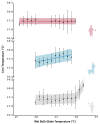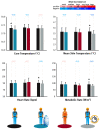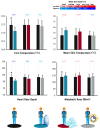Occupational Heat Stress: Multi-Country Observations and Interventions
- PMID: 34200783
- PMCID: PMC8296111
- DOI: 10.3390/ijerph18126303
Occupational Heat Stress: Multi-Country Observations and Interventions
Abstract
Background: Occupational heat exposure can provoke health problems that increase the risk of certain diseases and affect workers' ability to maintain healthy and productive lives. This study investigates the effects of occupational heat stress on workers' physiological strain and labor productivity, as well as examining multiple interventions to mitigate the problem.
Methods: We monitored 518 full work-shifts obtained from 238 experienced and acclimatized individuals who work in key industrial sectors located in Cyprus, Greece, Qatar, and Spain. Continuous core body temperature, mean skin temperature, heart rate, and labor productivity were collected from the beginning to the end of all work-shifts.
Results: In workplaces where self-pacing is not feasible or very limited, we found that occupational heat stress is associated with the heat strain experienced by workers. Strategies focusing on hydration, work-rest cycles, and ventilated clothing were able to mitigate the physiological heat strain experienced by workers. Increasing mechanization enhanced labor productivity without increasing workers' physiological strain.
Conclusions: Empowering laborers to self-pace is the basis of heat mitigation, while tailored strategies focusing on hydration, work-rest cycles, ventilated garments, and mechanization can further reduce the physiological heat strain experienced by workers under certain conditions.
Keywords: breaks; heat stress; hydration; ice slurry; labor productivity; mechanization; mitigation; physiological strain; ventilated garments; work.
Conflict of interest statement
The authors declare no conflict of interest.
Figures









References
-
- Piil J.F., Lundbye-Jensen J., Christiansen L., Ioannou L., Tsoutsoubi L., Dallas C.N., Mantzios K., Flouris A.D., Nybo L. High prevalence of hypohydration in occupations with heat stress—Perspectives for performance in combined cognitive and motor tasks. PLoS ONE. 2018;13:e0205321. doi: 10.1371/journal.pone.0205321. - DOI - PMC - PubMed
-
- Page L., Sheppard S. Heat Stress: The Impact of Ambient Temperature on Occupational Injuries in the US. Department of Economics Working Papers; Williamstown, MA, USA: 2016.
-
- Varghese B.M., Hansen A., Bi P., Pisaniello D. Are workers at risk of occupational injuries due to heat exposure? A comprehensive literature review. Saf. Sci. 2018;110:380–392. doi: 10.1016/j.ssci.2018.04.027. - DOI
-
- Zander K.K., Botzen W.J., Oppermann E., Kjellstrom T., Garnett S.T. Heat stress causes substantial labour productivity loss in Australia. Nat. Clim. Chang. 2015;5:647. doi: 10.1038/nclimate2623. - DOI
Publication types
MeSH terms
LinkOut - more resources
Full Text Sources
Medical

